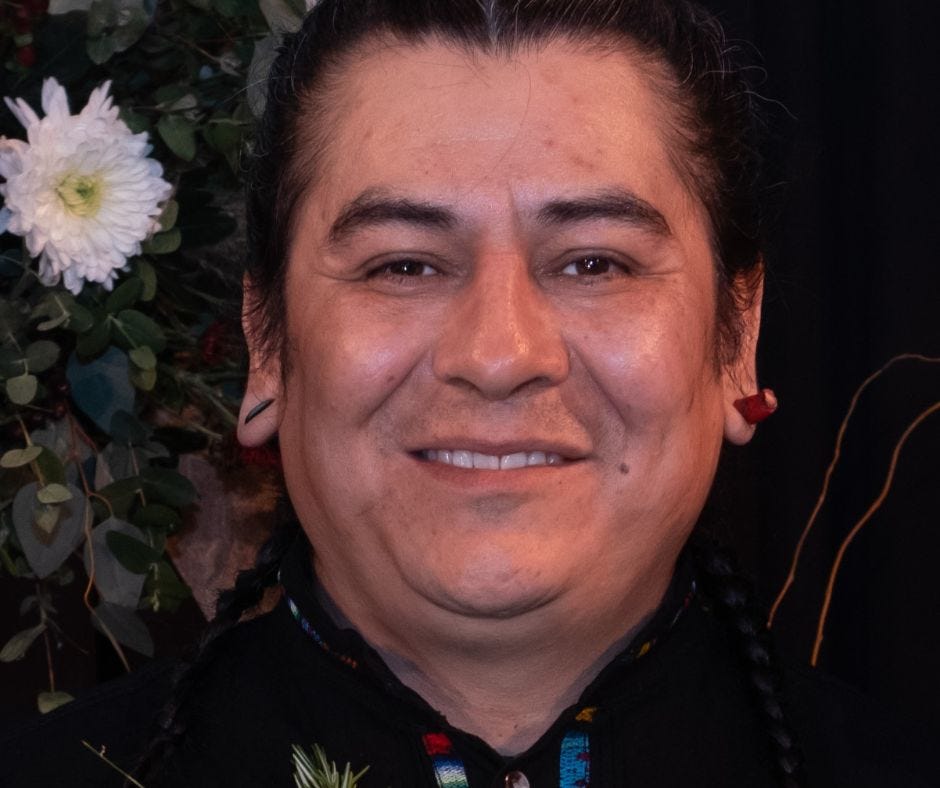Lifting up voices through audio
Is community media ignored when it comes to sharing Latino life and stories?
In this final OIGO of 2023, I wanted to devote a conversation to community media, its strengths and weaknesses when it comes to elevating the voices of the Latinx community.
My affinity for community media runs deep. I shared with Current in 2017 how community radio played a monumental role in shaping my life. ☀️ While acknowledging its limitations, I find community media can also exhibit remarkable innovation given its resource constraints.
For those unfamiliar, community media encompasses a particular tier of noncommercial broadcasting that includes PEG TV (public, educational, and government television, a.k.a. public access TV), community radio licensees, and low-power FM. 🎤 All are relatively lightly staffed, where the commitment is local access to the airwaves rather than professional broadcasting. In 2007, Michael Huntsberger wrote an exhaustive history of community radio and its aesthetics. The most interesting facet is how community stations actively engage volunteers in the creation of on-air programming. Think of it as a YouTube or Tiktok for radio.
So, bad news first… 😞
The outcome of taking individuals with no broadcast experience, providing varying degrees of training, and entrusting them with control of the license often leads to what might be anticipated: programming that can be challenging to listen to, cater to niche interests, or result in a schedule that sounds chaotic. 😕 However, in this context, the sonic quality of a station can take a back seat to the ideal of media access.
Additionally, the diverse sound doesn't usually translate to shifts in diversity itself. 📉 In my view, community media leadership is often more representative of dominant demographics compared to the broader public media landscape, partly due to the smaller pool of staff and board members. Although volunteer producers may reflect greater diversity, those with the means and free time to create daily and weekly programming tend to be more homogeneous. Moreover, the volunteerism decline nationwide is something community radio particularly is contending with.
But now the good… 😊
Despite these challenges, the community media ethos is marked by a willingness to experiment and represent diverse voices in a city or town. Consequently, you are more likely to encounter Spanish and Latinx-themed programs, even when the rest of the station is not. 🎙️ Noteworthy efforts abound, from KIND-LP, whose Spanish and Mixteco content garnered attention on CNN, to KBBF celebrating 50 years of bilingual programming. Numerous stations provide airtime for volunteer hosts presenting music and talk shows in Spanish, showcasing the richness and diversity of community-driven content.
Finally, some stations in this cohort are trying to address issues like limited reach and leadership diversity — as we all are, and should be. 🎉
I talked with Brujo de la Mancha, host of a program, Nika Tlaka, on PhillyCAM’s low-power FM, to share his story and illustrate the value of these spaces. I don’t expect public media to adopt a volunteer host dynamic, but perhaps this interview is a springboard. 🌊 As public media seeks Latine inclusion, what open avenues exist to stoke organic participation? Might fresh voices emerge with rough tools and an invitation to tinker? I'm inspired by those making space for Spanish speakers to simply be heard in noncommercial broadcasting.
Radio host de la Mancha was born in Mexico City into a mixed Mexican-indigenous and Spanish working-class family. He moved to Southwest Philadelphia in 1998. The focus of his radio programming is around raising awareness of the indigenous roots in Mexico prior to 1492. He’s also a filmmaker and engaged in popular arts in education among diverse populations in Philadelphia. Some of this work has included after-school programs, senior centers and juvenile correction centers. 👇🏽
What prompted you to want to get into audio and video?
At family parties, my dad would always record conversations on his radio. He made a little archive — family stories. That's how I picked it up, and then I started recording. When I came to Philadelphia on 1998, I was part of a pirate radio station. I had access to some equipment and it was easy to pick up the mixer, because my neighbor was a guy who liked to mix music. And then I had the opportunity to become a radio host.
What has been your personal evolution from when you started to what you're doing now in terms of content?
My first show was on video in which I play any kind of music composed and directed in Spanish or with a Spanish performer. Our diaspora is big and small in so many ways, but we always get music from different people and different places.
As a video producer, I created in 2006 a documentary that talks about the first migrants from Mexico to Philadelphia — how they recall their neighborhoods. Then I took a break for 10 years and made another documentary about the lack of spaces for indigenous people. In Philly, we don't have an office. We don't have a department. So if you are from south of the border, you find contemporary Spanish Latino communities but few mestizos. My third documentary talks about Mexicans and Philadelphia through the pandemic. So my evolution went from music to radio to video to talk about the diversity of ourselves, our neighborhoods and the whole continent.
Many public media organizations would love to engage these audiences in particular. PhillyCAM is a low power FM, so it has less resources and less reach, but invites the community in. Is there an advantage to what PhillyCAM is doing versus a larger organization?
Well, I mean the good thing that we have the internet so they can check our website, and the radio is there too. Wherever you are, you can always hear us.
What PhillyCAM has given is space to people like me, who don't have the background training or did not go to school for audio technology. They teach you things that people where I came from needed. Those picking up audio and coming in from the streets don't get the door open often to speak freely.
You do this as a volunteer. So what is your hope for the work that you're doing?
Coming to this country, I had forty dollars and a backpack. I now have other opportunities though community radio. I have been able to push forward all these other people's stories and have another opportunities to myself too to learn. So, I’m happy for community radio in any way.
PhillyCAM gives this access to me to talk about what I think or what I feel about the indigenous community and also new migrants here in Philadelphia. The Mexican community in Philadelphia really has grown into a strong presence for the last 20 years.
How valuable is it to be on a radio station, given the fact that it does have very small reach versus, say, social media or YouTube?
With radio, I have accessibility that surprises me, because other people of different demographics hear the conversation. Sometimes people tell me, ‘I drive in downtown, looking for a radio station, and I heard you.’ You never know who's you going to be inspired for something. That's what it matters. And when you are in your community, you reach out and strive to be part of people’s reality that way.
There's indeed a magic in discovery. I have to be very intentional or slightly intentional online, but radio is also about surprise.
It is wonderful to be in a small radio station. You never know who's going to turn on the radio or go online.
You've been developing this as something that is not necessarily your career path.
Talking about something in the community and having the opportunity to be on the radio and give the indigenous point of view is important. All the other situations other indigenous communities go through are part of my life too. So because it's my life I get a chance to choose representative songs and interview people that listeners never expected. They tell me, ‘it's like I’m drinking a cup of coffee with you.’ Let's talk about who you are, and give you a chance to see a person and show they matter. And, for example, people may never think a guest is indigenous or mestizo, or how you want to describe yourself to the world, and things like that.
This is not hobby. It's not a business, but it is serious, It’s something that, as an artist, I can give. I'm grateful.
What advice would you give a young person that was exploring some of these conversations and was interested in media?
Try to do something new and discover it. You won't break your ears and equipment, but you can create. Never stop. There are so many possibilities and you never know what new ideas you could push forward. 🟢
Cafecito: stories to discuss ☕
If you have missed the New England News Collaborative series on Hispanics and the outdoors, the fifth episode is out and worth your time. ⛰️
Among the Nieman Journalism Lab predictions, Mael Vallejo has an essay on perils facing Latin American journalists. 🛎️ “The lack of successful business models in the region has also made journalists precarious. They face poor salaries, no employment benefits, and very little protection from their media outlets in order to be able to carry out risky coverage.”
To commemorate the passing of Maria Martin, Latino USA reposted its 30 Años: An Oral History of Latino USA episode from earlier this year. 🔉
The narrative of Black/Latino tension is a common one, but Triibe's in-depth exploration into the roots of initiatives to overturn Chicago's sanctuary city status, and how these conflicts shape the narrative, exemplifies an engaging storytelling approach. 🖊️
To watch: CAA has launched CAA Latino, “an agency-wide, cross-department initiative to drive new opportunities to its Latino and Hispanic clients.” ⭐ Given its high-profile roster, CAA’s move is certain to have ripple effects across entertainment, of which public television has become a bigger player in in recent years.
El radar: try this 📡
See about holiday trees and inclusion. Over 150 people gathered in the Colorado mountains to celebrate their public lands with a Latine holiday party, eat tamales, and cut down a Christmas tree during an event organized by the U.S. Forest Service and a Latino environmental group. 🌲 Aspen Public Radio covered the bilingual and bi-cultural gathering, which prompts me to wonder if the agencies managing public lands near you are doing this too.
Examine ballot access in Spanish. A ballot translation error sparked a look from Connecticut Public at the obstacles to Spanish-language access and varied forms of Latino-targeted misinformation. 🗳️ In that state, Latino elected officials are seeking to confront complex Spanish-language disinformation they feel unprepared to tackle.
Look into seasonal workers settling down. Maine Public did just that, and I suspect your state has equally fascinating stories. Seasonal workers travel to many regions to support farming, tourist industries and other businesses. But many also make homes in their towns of residence. 🏠 The effects of new residents can resonate months and years later.
And settling farther out. WBEZ visited a community adjacent to a Latinx-majority Chicago suburb. 🚧 The stories of those creating businesses and how city leaders feel is similar to what may be happening in your community.
Oh also, see if your state is pitching to monolingual Spanish and bilingual workers. High Plains Public Radio covered how Oklahoma institutions are recruiting with tailored appeals to Spanish speakers. ✏️ Some may recall previously hostile positions states may have taken to non-English outreach. However, I suspect such hard lines are going away. Is this happening near you?
The next OIGO is Jan. 19. Thank you for a fabulous year two of OIGO. We’re back for new newsletters post-MLK with a look at trends for the year ahead. Felices fiestas a todos. My inbox is always open for a visit, interview or question. Reach out anytime.
🥤 You are welcome to buy me a coffee if you’d like to support the newsletter.







